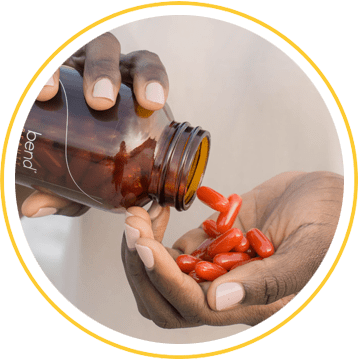
At Bend Beauty, we’re all about creating beautiful, healthy skin from the inside out. Diet is one of the greatest contributors to a radiant complexion. Curious to learn which nutrient-packed foods (and beverages) will feed your skin what it needs to glow? Let’s dive in.
Green Tea
Green tea contains polyphenols that provide strong antioxidant protection for skin (1). Experimental studies show it reduces inflammation (1) and prevents formation of enzymes that breakdown collagen and elastin (2).
Cocoa
Cocoa’s potential to prevent and treat skin diseases is attributed partly to its antioxidant, anti-inflammatory and immune modifying effects that can neutralize oxidative stress. It has shown promise for skin conditions, including cancer, psoriasis, acne, wound healing (3), and atopic eczema (4, 5).
Cruciferous Vegetables
Cruciferous vegetables include broccoli, cauliflower, cabbage, kohlrabi, kale, bok choy, arugula, Brussels sprouts, mustard and collard greens, watercress, turnip, and radishes. They contain a natural antioxidant stimulator called sulforaphane that aids liver detoxification. Fun fact – sulforaphane is an ingredient included in our newest product, RESET.
Mushrooms
Mushrooms are rich in dietary fiber, essential amino acids (6), selenium, potassium, vitamins B2, 3, and D (10), and many bioactive compounds, especially those benefiting immune health, although the quantity of these compounds differs among different mushroom types (6). Polysaccharides and specific proteins account for most of their immunomodulating and anti-tumor effects, while lipids and phenols provide health-enhancing cholesterol-lowering and antioxidant effects, respectively (7). Some extensively studied medicinal mushrooms include Cordyceps, Reishi and Tremella.
Purple Berries
Did you know that plants produce color partly to protect themselves from the sun? Well, those same intense and beautiful red, purple, and blue hues, can also protect you! The roughly 600 naturally occurring, water soluble, intensely colored anthocyanins, particularly rich in berries, absorb blue-green light and UV rays (8). They are found in many foods including blueberries, blackberries, raspberries, haskap, strawberries, cherries, chokecherries, currents, purple grapes, beets, red cabbage, and red beans (9).
We challenge you to incorporate some, or all, of these incredible items into your diet frequently and note the changes in your skin over time. If you’re interested in learning more about RESET, our latest product which contains sulforaphane, click here.
Stay tuned for part 2!
References:
- Dunaway S, Odin R, Zhou L, Ji L, Zhang Y, Kadekaro AL. Natural Antioxidants: Multiple Mechanisms to Protect Skin From Solar Radiation. Front Pharmacol. 2018 Apr 24;9:392. doi: 10.3389/fphar.2018.00392. PMID: 29740318; PMCID: PMC5928335. Accessed online on November 27, 2020 at https://pubmed.ncbi.nlm.nih.gov/29740318/
- Schagen SK, Zampeli VA, Makrantonaki E, Zouboulis CC. Discovering the link between nutrition and skin aging. Dermatoendocrinol. 2012;4(3):298-307. doi:10.4161/derm.22876 Accessed online o November 21, 2020 at https://www.ncbi.nlm.nih.gov/pmc/articles/PMC3583891/
- Scapagnini G, Davinelli S, Di Renzo L, De Lorenzo A, Olarte HH, Micali G, Cicero AF, Gonzalez S. Cocoa bioactive compounds: significance and potential for the maintenance of skin health. Nutrients. 2014 Aug 11;6(8):3202-13. doi: 10.3390/nu6083202. Accessed online on December 15, 2019 at https://www.ncbi.nlm.nih.gov/pmc/articles/PMC4145303/
- Bril-Gil M, Massot-Cladera M, Perez-Cano FJ, Castellote C, Franch, A, Castell M. A diet enriched with cocoa prevents IgE synthesis in a rat allergy model. Pharmacological Research 2012;65(6):603–608. Accessed online on December 21, 2019 at http://diposit.ub.edu/dspace/bitstream/2445/33013/1/614291.pdf
- Kang H, Lee CH, Kim JR, Kwon JY, Son MJ, Kim JE, Lee KW. Theobroma cacao extract attenuates the development of Dermatophagoides farinae-induced atopic dermatitis-like symptoms in NC/Nga mice. Food Chem. 2017 Feb 1;216:19-26. doi: 10.1016/j.foodchem.2016.07.141. Epub 2016 Jul 27.
- Zhao S, Gao Q, Rong C, Wang S, Zhao Z, Liu Y, Xu J. Immunomodulatory Effects of Edible and Medicinal Mushrooms and Their Bioactive Immunoregulatory Products. J Fungi (Basel). 2020 Nov 8;6(4):269. doi: 10.3390/jof6040269. PMID: 33171663; PMCID: PMC7712035. Accessed online on December 8, 2020 at https://www.ncbi.nlm.nih.gov/pmc/articles/PMC7712035/
- Motta F, Gershwin ME, Selmi C. Mushrooms and immunity. J Autoimmun. 2020 Dec 1;117:102576. doi: 10.1016/j.jaut.2020.102576. Epub ahead of print. PMID: 33276307. Accessed online on December 8, 2020 at https://pubmed.ncbi.nlm.nih.gov/33276307/
- Rojo LE, Roopchand DE, Graf B, Cheng DM, Ribnicky D, Fridlender B, Raskin I. Role of Anthocyanins in Skin Aging and UV Induced Skin Damage. Anthocyanins in Health and Disease. Chapter 11, 2013:307-319. DOI: 10.1201/b15554-12. Accessed online on December 8, 2020 at https://www.researchgate.net/publication/281031602_Role_of_Anthocyanins_in_Skin_Aging_and_UV_Induced_Skin_Damage
- Wang LS, Stoner GD. Anthocyanins and their role in cancer prevention. Cancer Lett. 2008 Oct 8;269(2):281-90. doi: 10.1016/j.canlet.2008.05.020. Accessed online on December 8, 2020 at https://pubmed.ncbi.nlm.nih.gov/18571839/
- Valverde ME, Hernández-Pérez T, Paredes-López O. Edible mushrooms: improving human health and promoting quality life. Int J Microbiol. 2015;2015:376387. doi: 10.1155/2015/376387. Epub 2015 Jan 20. PMID: 25685150; PMCID: PMC4320875. Accessed online on December 8, 2020 at https://www.ncbi.nlm.nih.gov/pmc/articles/PMC4320875/

